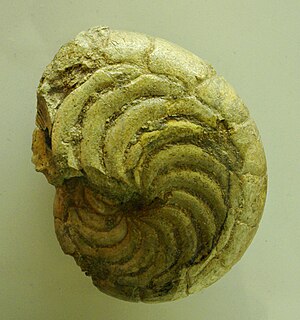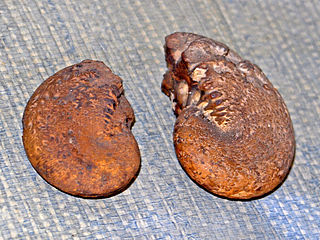Related Research Articles

Ammonoids are a group of extinct marine mollusc animals in the subclass Ammonoidea of the class Cephalopoda. These molluscs, commonly referred to as ammonites, are more closely related to living coleoids than they are to shelled nautiloids such as the living Nautilus species. The earliest ammonites appeared during the Devonian, and the last species vanished in the Cretaceous–Paleogene extinction event.

Goniatids, informally goniatites, are ammonoid cephalopods that form the order Goniatitida, derived from the more primitive Agoniatitida during the Middle Devonian some 390 million years ago. Goniatites (goniatitids) survived the Late Devonian extinction to flourish during the Carboniferous and Permian only to become extinct at the end of the Permian some 139 million years later.
Frechites is an early Triassic ammonite, a kind of cephalopod with an external shell, included in the ceratitid family Beyrichitidae.
Ussuria is a genus of Lower Triassic ammonites with a smooth, involute discoidal shell with submonophyllic sutures, belonging to the ceratitid family Ussuriidae.

Ceratitida is an order that contains almost all ammonoid cephalopod genera from the Triassic as well as ancestral forms from the Upper Permian, the exception being the phylloceratids which gave rise to the great diversity of post Triassic ammonites.
Tornoceratatina is one of two suborders included in the Goniatitida, characterized by generally involute, subdiscoidal shells and by sutures in which the ventral ones are undivided.
The Posttornoceratidae are Late Devonian goniatites (Ammonoidea) included in the superfamily Tornoceratoidea. The family, Posttornoceratidae, named by Bogoslovsky in 1962, is based on the genus Posttornoceras, named by Wedekind in 1910, originally included in the Tornoceratidae.

Ammonitina comprises a diverse suborder of ammonite cephalopods that lived during the Jurassic and Cretaceous periods of the Mesozoic Era. They are excellent index fossils, and it is often possible to link the rock layer in which they are found to specific geological time periods.

Aturia is an extinct genus of Paleocene to Miocene nautilids within Aturiidae, a monotypic family, established by Campman in 1857 for Aturia Bronn, 1838, and is included in the superfamily Nautilaceae in Kümmel 1964.
Zetoceras is an extinct ammonoid cephalopod genus from the suborder Phylloceratina that lived during the Early and Middle Jurassic in what is now Europe, and is included in the (family) Phylloceratidae.
The Clydonautiloidea are a superfamily within the nautiloid order Nautilida characterized by smooth, generally globular, shells with nearly straight sutures, in early forms, but developing highly differentiated sutures in some later forms. Where known, the siphuncle tends to be central to subcentral.
Syringonautilidae is a family of Nautiloidea from the middle to late Triassic. Syringonautilidae comprise the last of the Trigonoceratoidea and are the source for the Nautilaceae which continued the Nautiloidea through the Mesozoic and into the Cenozoic right down to the recent. Syringonautilidae is a strictly Triassic family, derived early in the Triassic from the Grypoceratidae.

Grypoceratidae is the longest-lived family of the Trigonoceratoidea, or of the near equivalent Centroceratina; members of the Nautilida from the Upper Paleozoic and Triassic.
The Centroceratidae is the ancestral family of the Trigonoceratoidea and of the equivalent Centroceratina; extinct shelled cephalopods belonging to the order Nautilida

Phylloceratidae is the predominant family of the Phylloceratina with some 15 or more genera found in rocks ranging from the Lower Jurassic to the Upper Cretaceous. Members of the Phylloceratidae are characterized by smooth, involute shells with very thin walls. Many are covered with fine growth lines but are usually without ribbing. Sutures are complex with the major and minor branches of the saddles with phylloid or spatulate endings.

Discophyllitidae are discoidal, generally evolute Phylloceratina from the Upper Triassic, derived from the Ussuritidae, in which the principal saddles of the suture have bifurcated or trifurcated endings, described as being di- or triphyllic. Discophyllitid shells are rather similar to those of the ancestral Ussuritidae and are distinguished primarily by the more complex suture. The Discophyllitidae provided the source for the Jurassic Phylloceratidae and Juraphyllitidae. Four genera are recognized and described.
The Naedyceras group comprises three similar and closely related openly coiled, gyroconic, genera within oncocerid family, Brevicoceratidae: Naedyceras, Gonionaedyceras, and Gyronaedyceras.
The Clydonautilidae are Middle and Upper Triassic nautiloid cephalopods, which are derivatives of the clydonautlicean family Liroceratidae, that have generally smooth, involute, globular to compressed shells, characterized by a suture with prominent lobes and saddles. The family is known to contain five genera, These are:
Proclydonautilus is a genus of nautiloids belonging to the Clydonautilidae known from the Upper Triassic of North America, Europe, and India.
Eowellerites is genus of ammonoid cephalopods belonging to the Welleritidae family. Species belonging to this genus lived in middle Pennsylvanian (Moscovian). Its fossils were found in USA and Japan. It had thinly discoidal shells with a quite wide umbilicus (U/D = 0.3 - 0.5). While in juvenile stages (up to 15 mm in diameter) venter is moderately rounded, it becomes slightly rounded to flattened when becoming mature (100 mm in diameter). 12-lobed suture has adventitious lobe on the first lateral saddle and is also characterized by an addition of an umbilical lobe. Sutural formula is (V1 V1) L1 L (U1 U2): I D. It has evolved from Winslowoceras henbesti and gave rise to genus Wellerites.